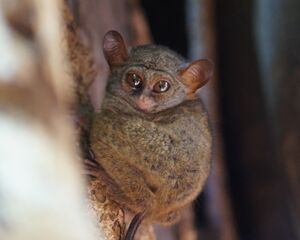Pygmy Tarsier Evolutioin
Introduction
Tarsius pumilus, often called the pygmy or mountain tarsier, is a small primate native to the Indonesian island of Sulawesi. [1] Mountain tarsiers are set apart from the other species in their genus by their long fur, elongated incisors, and nails on their hands and feet that resemble claws. These adaptations help the animals survive in the cold forests they inhabit; their incisors are used for grooming while the claws enhance their grip on the rough trees they seek shelter in. [2] The animals of the genus Tarsius are known for their extremely large ears and eyes, two to three pairs of nipples, their carnivorous diet, and their long tarsal bones (the source of their name). [3] The pygmy tarsier's ears are uniquely smaller than other members of the genus, but they can still move and fold their ears [4] to enhance their already incredible hearing. Some species of tarsier can hear above 90 kHz [5], an adaptation that enhances their nocturnal lifestyle. Their notable eyes are massive, often outweighing their brains and lacking a tapetum lucidum, or "eyeshine." This keeps their location hidden, since there is no eye reflection to betray their position to predators. [6] Pygmy tarsiers were thought to be extinct until they were re-discovered in 2008, for the first time in 70 years. [7] The phylogenetic placement of the genus Tarsius is widely debated, and many researchers have undertaken genetic experiments to identify their position in relation to other primates.

At right is a sample image insertion. It works for any image uploaded anywhere to MicrobeWiki. The insertion code consists of:
Double brackets: [[
Filename: PHIL_1181_lores.jpg
Thumbnail status: |thumb|
Pixel size: |300px|
Placement on page: |right|
Legend/credit: Electron micrograph of the Ebola Zaire virus. This was the first photo ever taken of the virus, on 10/13/1976. By Dr. F.A. Murphy, now at U.C. Davis, then at the CDC.
Closed double brackets: ]]
Other examples:
Bold
Italic
Subscript: H2O
Superscript: Fe3+
Section 1 Genetics
Include some current research, with at least one image.
Sample citations: [8]
[9]
A citation code consists of a hyperlinked reference within "ref" begin and end codes.
Section 2 Microbiome
Include some current research, with a second image.
Conclusion
Overall text length (all text sections) should be at least 1,000 words (before counting references), with at least 2 images.
Include at least 5 references under References section.
References
- ↑ Kathleen Downey "PYGMY TARSIER TARSIUS PUMILUS" 2019. New England Primate Conservancy
- ↑ Shekelle Myron "The History and Mystery of the Mountain Tarsier, Tarsius pumilus" Primate Conservation, 23(1):121-124 (2008).
- ↑ Shannon Gurskey-Doyen "Married to the Mob" 2010. Natural History Vol. 119
- ↑ Kathleen Downey "PYGMY TARSIER TARSIUS PUMILUS" 2019. New England Primate Conservancy
- ↑ [10.1098/rsbl.2011.1149 Marissa A. Ramsier et. al. "Primate communication in the pure ultrasound" Biology Letters, 2012]
- ↑ Shannon Gurskey-Doyen "Married to the Mob" 2010. Natural History Vol. 119
- ↑ [nbcnews.com/id/wbna27786771 Alan Boyle "Real-life Furbys rediscovered" 2008. NBC News]
- ↑ Hodgkin, J. and Partridge, F.A. "Caenorhabditis elegans meets microsporidia: the nematode killers from Paris." 2008. PLoS Biology 6:2634-2637.
- ↑ Bartlett et al.: Oncolytic viruses as therapeutic cancer vaccines. Molecular Cancer 2013 12:103.
- ↑ Lee G, Low RI, Amsterdam EA, Demaria AN, Huber PW, Mason DT. Hemodynamic effects of morphine and nalbuphine in acute myocardial infarction. Clinical Pharmacology & Therapeutics. 1981 May;29(5):576-81.
Edited by M. Kate Ford, student of Joan Slonczewski for BIOL 116 Information in Living Systems, 2021, Kenyon College.
